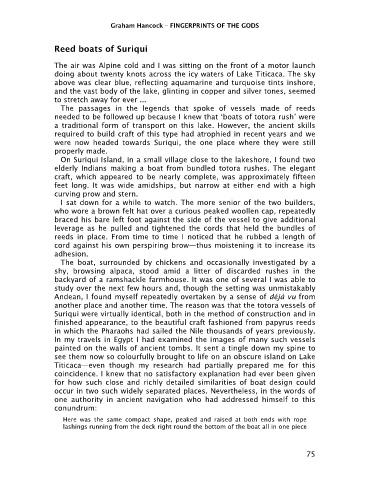Page 77 - Fingerprints of the Gods by Graham Hancock
P. 77
Graham Hancock – FINGERPRINTS OF THE GODS
Reed boats of Suriqui
The air was Alpine cold and I was sitting on the front of a motor launch
doing about twenty knots across the icy waters of Lake Titicaca. The sky
above was clear blue, reflecting aquamarine and turquoise tints inshore,
and the vast body of the lake, glinting in copper and silver tones, seemed
to stretch away for ever ...
The passages in the legends that spoke of vessels made of reeds
needed to be followed up because I knew that ‘boats of totora rush’ were
a traditional form of transport on this lake. However, the ancient skills
required to build craft of this type had atrophied in recent years and we
were now headed towards Suriqui, the one place where they were still
properly made.
On Suriqui Island, in a small village close to the lakeshore, I found two
elderly Indians making a boat from bundled totora rushes. The elegant
craft, which appeared to be nearly complete, was approximately fifteen
feet long. It was wide amidships, but narrow at either end with a high
curving prow and stern.
I sat down for a while to watch. The more senior of the two builders,
who wore a brown felt hat over a curious peaked woollen cap, repeatedly
braced his bare left foot against the side of the vessel to give additional
leverage as he pulled and tightened the cords that held the bundles of
reeds in place. From time to time I noticed that he rubbed a length of
cord against his own perspiring brow—thus moistening it to increase its
adhesion.
The boat, surrounded by chickens and occasionally investigated by a
shy, browsing alpaca, stood amid a litter of discarded rushes in the
backyard of a ramshackle farmhouse. It was one of several I was able to
study over the next few hours and, though the setting was unmistakably
Andean, I found myself repeatedly overtaken by a sense of déjà vu from
another place and another time. The reason was that the totora vessels of
Suriqui were virtually identical, both in the method of construction and in
finished appearance, to the beautiful craft fashioned from papyrus reeds
in which the Pharaohs had sailed the Nile thousands of years previously.
In my travels in Egypt I had examined the images of many such vessels
painted on the walls of ancient tombs. It sent a tingle down my spine to
see them now so colourfully brought to life on an obscure island on Lake
Titicaca—even though my research had partially prepared me for this
coincidence. I knew that no satisfactory explanation had ever been given
for how such close and richly detailed similarities of boat design could
occur in two such widely separated places. Nevertheless, in the words of
one authority in ancient navigation who had addressed himself to this
conundrum:
Here was the same compact shape, peaked and raised at both ends with rope
lashings running from the deck right round the bottom of the boat all in one piece
75

